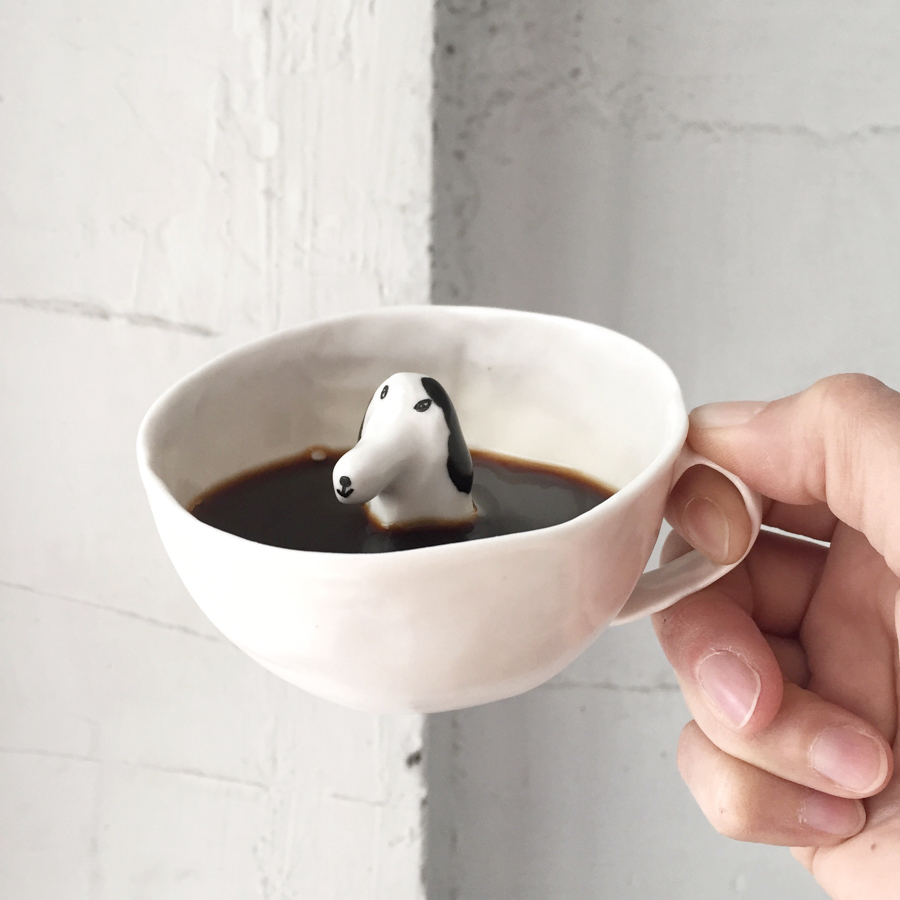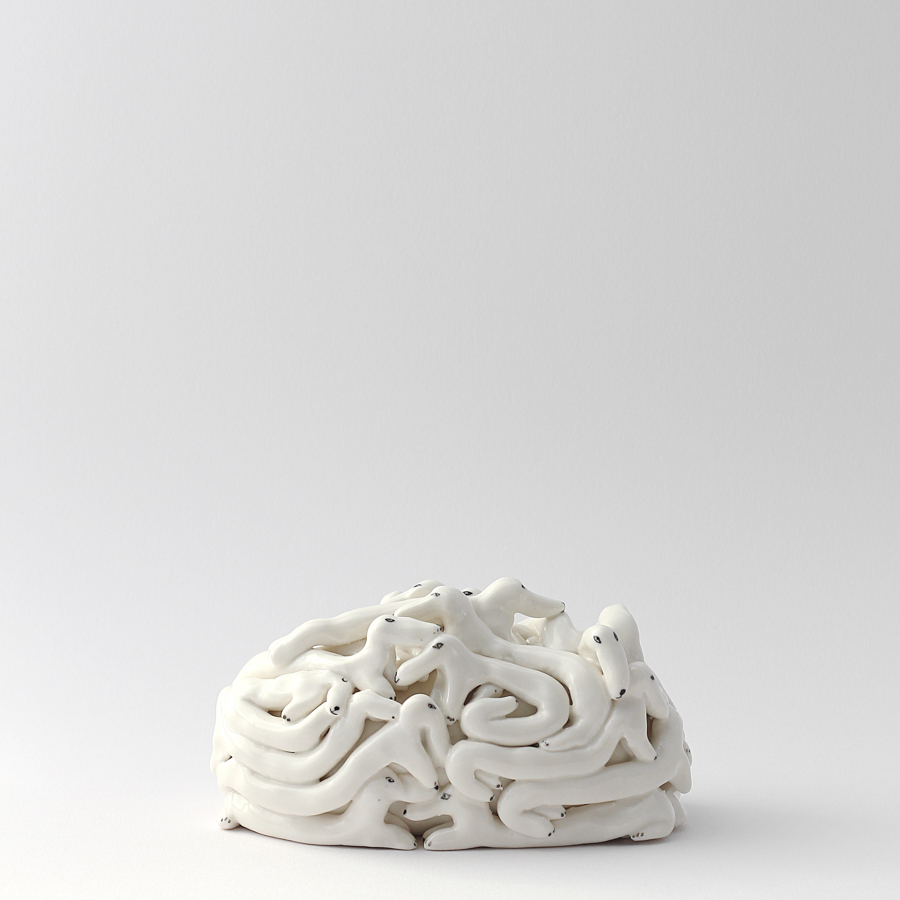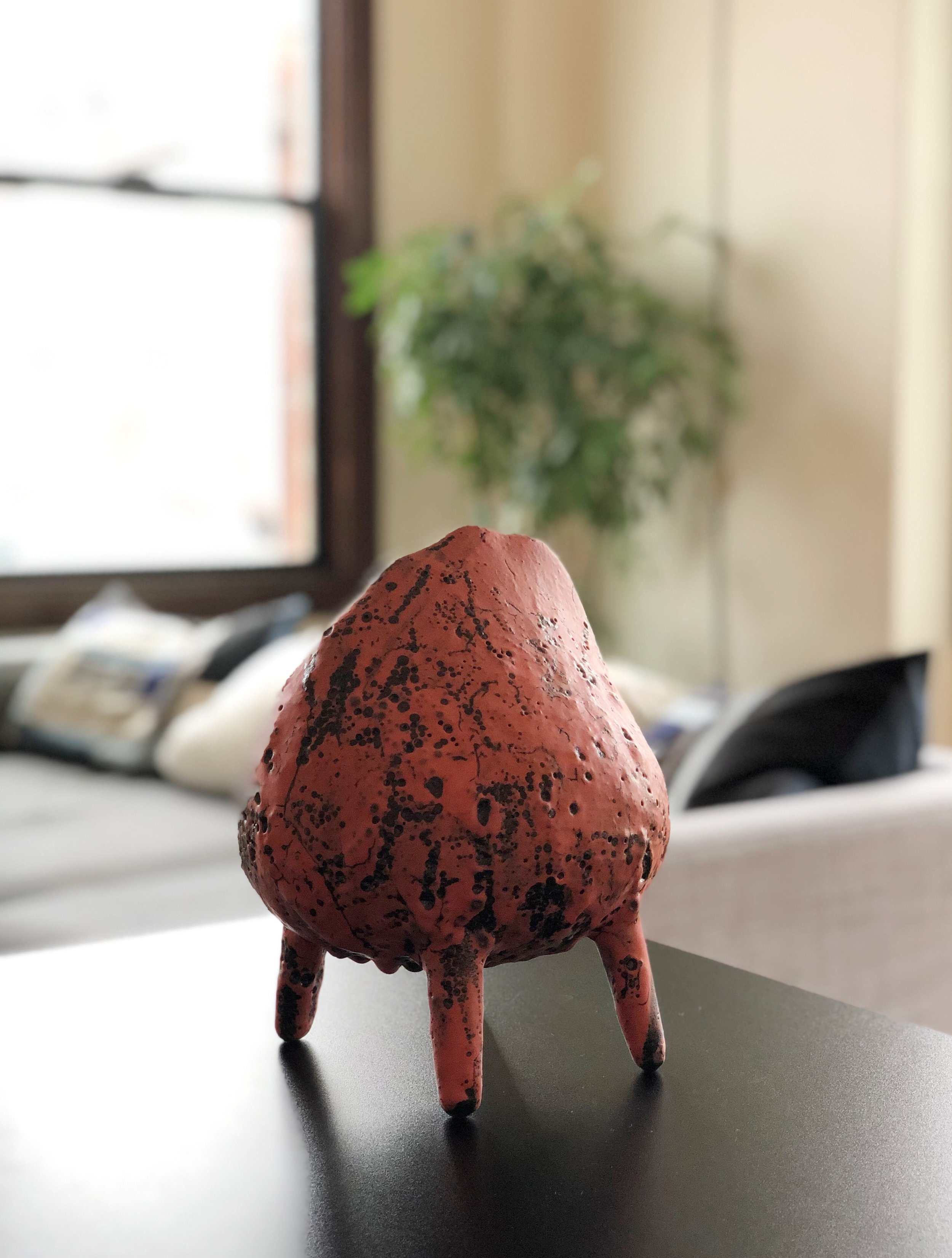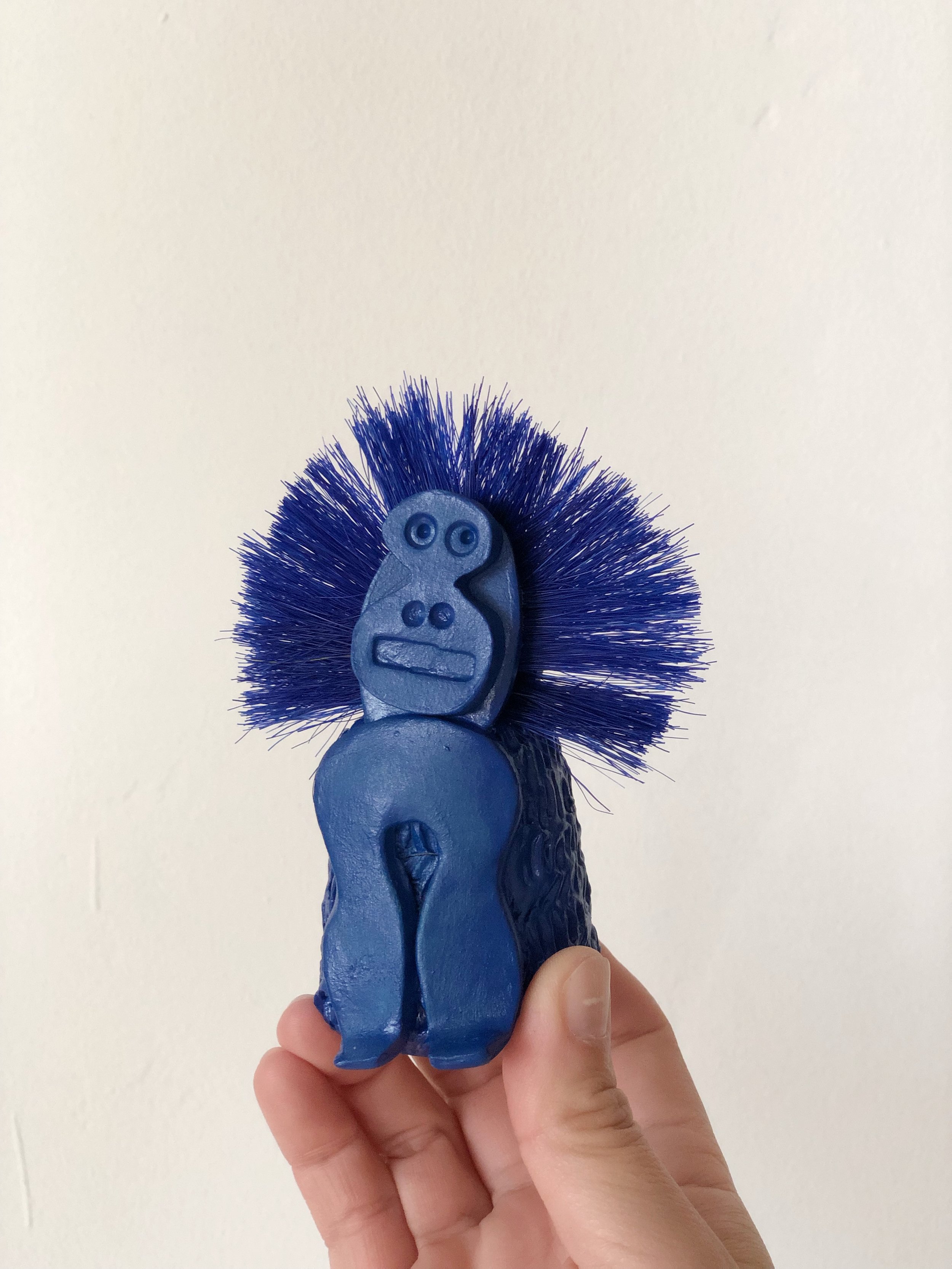Eleonor Boström
My work is focused on sculptures with function and sculptural utility goods. I like to twist and turn my characteristic dog sculptures, always trying to find new meanings and functions.
Interview with Eleonor Boström
Questions by Andreana Donahue
Hi Eleonor! How were you first exposed to art growing up in Sweden? Are there other makers in your family?
My parents were always very encouraging of me and my sister growing up to express ourselves through drawing, painting and crafting. We always had all art supplies we could need, very spoiled in that way, which I’m very grateful for. My strongest art memory from being a child was when my family visited Monet’s garden outside of Paris, I think I was around 7. Was around then I decided I wanted to work with art. My grandmother was a seamstress, she encouraged me to sew, I got two sewing machines from her when I graduated high school. My aunt was an metal artist and my mom is very creative, knows so much about sewing, stitching and crocheting, I always ask her for pointers.
Can you talk about how you began to pursue art-making through drawing and how this transitioned into ceramics? What is the relationship between the two?
I was amazed of one of my kindergarten teachers that could draw He-man and She-ra and my mom made the best unicorn. I wanted to be able to draw like them with what seemed to be with such an ease to me. And I’ve continued to draw, I want to fill blank spaces and pages, and ceramics is like a blank canvas but then I add form and function. The ceramic pieces comes to life for me in combination with the illustration. The two parts are in a relationship that have become dependent on each other.
Sweden is a prominent contributor of Scandinavian design; has the emphasis of this movement on functionality and minimalism impacted your aesthetic?
The part of function is strong for me, that there should always be a purpose for my design. I think that derives from my Swedish heritage definitely. But I’m very much influenced by humorous potters in the Swedish design world, like Lisa Larson and Stig Lindberg.
Can you talk about some artists and designers who have influenced your work?
As I mentioned Lisa Larsson and Stig Lindberg, and also the author and illustrator Tove Jansson, best known for the Moomin books.
You currently split your time between Stockholm and San Francisco. Can you tell us about your current studio(s)? What is an ideal day like for you?
My studio in Stockholm I started with my old class mate Emelie, we’ve run it together for 8 years. It’s in an old part of Stockholm and the building is from the late 1700. It’s small and cute and works perfectly for us. My SF studio is in Bayview, it’s a large space in a artist building that I share with one other ceramicist and two artists. I like to walk to the studio over a hill, sometimes I stop there to answer morning emails while overlooking the city. In the work day I drink coffee, eat chocolate and listen to podcasts (My Favorite Murder) while making pups. I also always try to squeeze in one new sculpture that’s not on my order sheet to pause the mind from the production mode.
Is your way of working defined by structure and discipline or would you describe it as more intuitive and spontaneous? Can you tell us about your process in general?
I’m super disciplined with studio work and intuitive and spontaneous with the mailbox and business part. I think it’s this way because the studio and production part I got down so therefore I can make a workable framework for it. But with the business I have no eduction and I’m learning as I go therefore it becomes more intuitive.
You primarily work in porcelain with a limited palette. Why are you drawn to this material specifically?
From starting out with clay I’ve been working with porcelain. It’s extremely hard. But compared to other clays I just can’t see them for my dogs, and I really like that it’s the clays body shining through, it’s the clay you see not a glaze that covering up a surface. It’s beautiful.
You create clever, domestic objects such as dogs that curl up to form saucers, sprout plant clippings from their heads, or become submerged inside coffee cups. How do you generate your ideas? Is humor important to you?
Subtle humor is something I strive for. And the dogs are portraying that for me. I’m inspired by everyday things, objects, can also be something a friend of mine says they need and then I try to think of how a dog could do that for me. And then the humor usually falls into place.
You produce large quantities of each functional object, yet they offer distinct, handmade qualities and endless variation in breeds of dog and character. Can you elaborate on this approach to working? Do you find navigating within the limitations of an established system to be liberating?
I like that the dogs limit me, being my theme. And then the painting being the liberating part of the production. Where the expressions comes in, making them all different. That the hand leaves a mark on the dogs made is important to me to show that there is a person behind every object.
Can you tell us about the motivation behind your dog piles?
I’ve been doing pup production for four years now and in beginning of 2018 I needed to create new things for myself, my own creativity. So every day I try to make one unique new thing. The piles came out of that. In more stressful times I can’t come up with new things but then I go back to the pile, there’s so many variations to be found in a dog pile. They’re just a chaos of dogs and it’s like doing a puzzle. Afternoon fun.
Ceramicists always face the prospect of loss during the firing process. What is your relationship with risk and chance?
I’m very detached until they’ve come through the last firing. I don’t get my hopes up too much ever with ceramics, because porcelain is so extra fuzzy also. I always make too much and then less than I need comes through the firings, it’s just how it is 💔
Do you compile imagery or videos of dogs for source material? Do you ever work from life or memory?
I follow some dog eccentric profiles on instagram and save special ones to be able to take out when I need extra inspiration. I also have some dog books in my studio. But mostly it’s from memory of dogs and dogs I meet on my walk to the studio. Right now there’s one neighbor corgi puppy that’s especially inspiring.
Do you tend to follow dog-related internet content, pop culture, or trends? If so, what are they?
Yes I do, I get a lot sent to me by friends. And I also follow @chillwildlife on Instagram. It’s a favorite who’s feed I can scroll down for an evening.
How does the work you include in exhibitions differ from your other work? Do they have a different status than sculptural utility goods or sculptures with function for you?
All my work is unique, but then there are variations to it. I like to combine it, but I always wanna maintain one price point that has a more cheap-ish price, pieces that I myself could have afforded as a student. That are smaller and easier to make. Then there are the pieces that are more one of a kind that I won’t replicate and have a higher price point. But in my exhibitions, wholesale lookbook and in my own webshop, you’ll always find a mix.
How do you negotiate your time to meet production or exhibition deadlines as your pieces become more sought after?
I work long hours. But when I take time off work, I really try to disconnect. But it’s also scary not to work because there’s always in the back of my mind that there might be a time when my pieces won’t be sought after.
Are you able to support yourself producing ceramics full-time? What is the best advice you’ve received on how to achieve or maintain this?
es I am and the best advice I received from my grandfather when I was in art school. He just said that if I’m gonna do this I must work hard, and don’t forget that. And that’s what I have been doing and are doing right now. A lot of my work ethic I got from him. The best part of working for yourself is that you are working for yourself and you alone steer your time and you’re doing something you love.
Can you share some non-visual works of art—from literature, music, or film—that are important to you?
I’m very drawn to musicals, like ‘The Umbrellas of Cherbourg’ and I’ve seen ‘Grease’ and ‘Rocky Horror Picture Show’ sooo many times. I like Tove Jansson’s novels for the same reason I like those musicals, they’re quirky, sad and colorful.
What are your interests outside of art-making?
Sewing is a big one, when I was a teenager I sewed a lot of my own clothes but today I’m mostly catching up on mending the ones I have. I get a bit nerdy and love reading about how to mend the best way. A new interest I’ve taken up is film photography in the recent year, got myself a Olympus OM-2 and it goes with me everywhere. I like the slow pace shooting with film, I don’t know straight away what I get. Not an instant gratification as pics with your iPhone. And sometimes a whole roll of film is crap, kind of how life is with ceramics too.
Can you tell us about some favorite objects you own that are made by other artists and designers?
I have a lot of ceramics and objects I’ve traded and bought over the years, it’s hard to choose but my top favorites are:
* Blue baboon by Jikijaku
* Blob by Brendan Monroe
* Mirrored glass globe by Swedish artist Sara Lundkvist
* Vase by Cassie Brown ‘C`est bon clay and cloth’
* Furbie painting Evah Fan
* Candlestick holder Boy by Swedish artist Maria Boij
Images below:
What are you excited about working on right now? Do you have any upcoming events, exhibitions, projects, or other news?
I’m excited that the month of January is coming, the spring time for me means slowing down the pace and finding time to experiment and make new pieces, especially for my 2019 lookbook. I also have two upcoming shows in Japan that I’m working towards presenting new pieces in and some new paintings that I’m very excited about!
Thanks so much for taking the time to talk with us!To find out more about Eleonor and her work, check out her website.








